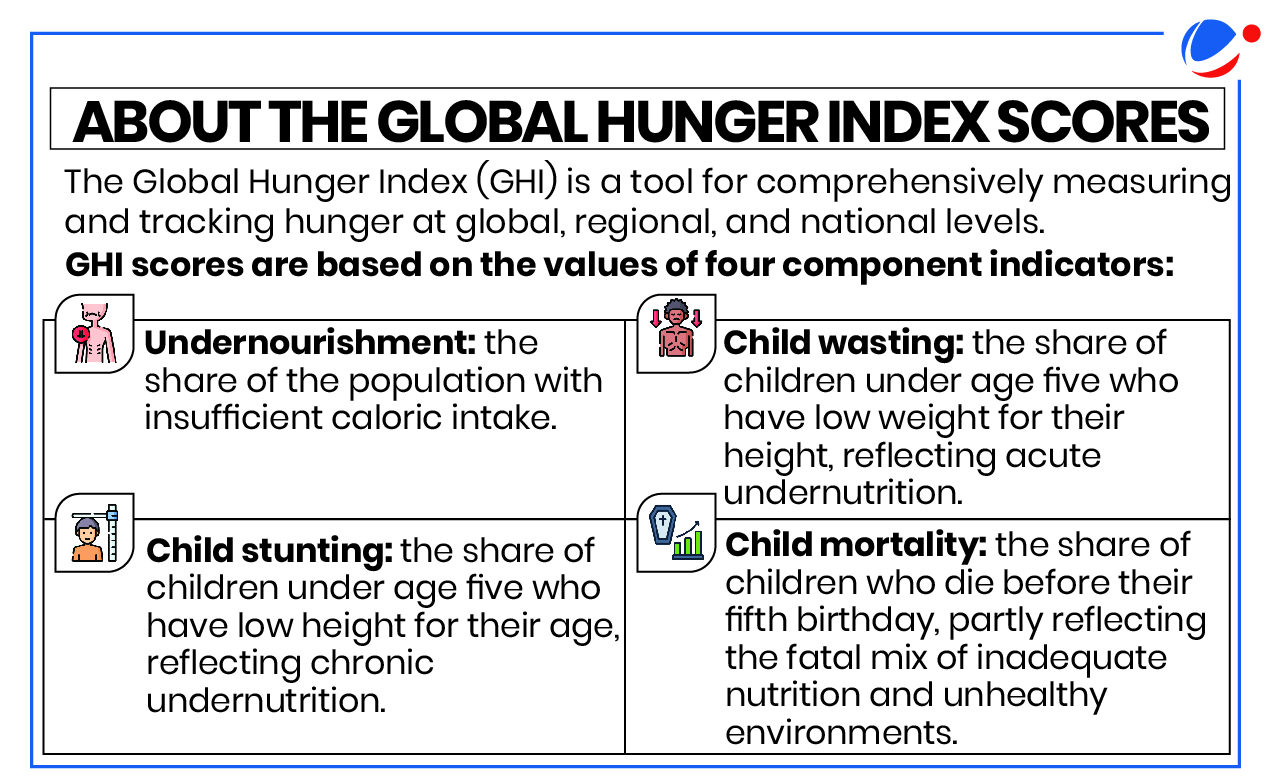Why in the news?
Global Hunger Index (GHI) 2024 has been released by Concern Worldwide and Welt Hunger Hilfe, Non-Government organizations from Ireland and Germany respectively.

Key findings of the GHI
- Global Findings:
- Hunger levels in 42 countries are at alarming levels, making goal of Zero Hunger by 2030 unattainable. At this pace of progress, world will not even attain a low hunger level until 2160.
- World's GHI score is 18.3, which is considered moderate in the severity of hunger scale.
- Report highlights link between Gender inequality, climate change, and hunger. Gender is intertwined with climate and food security challenges in ways that respective policies and interventions often ignore.
- Women and girls are typically hardest hit by food insecurity and malnutrition. They also suffer disproportionately from the effects of weather extremes and climate emergencies.
- Hunger levels in 42 countries are at alarming levels, making goal of Zero Hunger by 2030 unattainable. At this pace of progress, world will not even attain a low hunger level until 2160.
- India Related findings:
- India ranks 105th out of 127th countries (up from 111th in 2023), falling under "serious" category with 41 other nations, including Pakistan and Afghanistan.
- India's GHI score: 27.3
- India's GHI score has fallen since 2000, however, child wasting and stunting remain very high.
- Child under-nutrition in India goes hand in hand with poor nutritional status of mothers underscoring need for attention to maternal health and nutrition.
However, according to experts, Global Hunger Index continues to be an erroneous measure of hunger with serious methodological issues and shows a malafide intent. Some of the issues highlighted by experts are:
Key issues with GHI
- Methodology: Three out of four indicators used for calculation of index are related to health of Children and cannot be representative of entire population.
- Child stunting, wasting and under-5 mortality are outcomes of complex interactions of various other factors like drinking water, sanitation, genetics, environment and utilization of food intake apart from hunger.
- Faulty indicator: Studies challenge use of stunting as an indicator of under nutrition, showing it occurs in well-nourished populations as well.
- Out-dated data set: Source of data used to construct Global Hunger Index is outdated and far from convincing.
- For example, the National Family Health Surveys (NFHS) data on stunting/wasting in under 5 years children are not available annually but every 8-10 years.
- Small sample size: The indicator of Proportion of the Undernourished (PoU) population is based on an opinion poll conducted on a very small sample size.
- The report lowers India's rank based on the estimate of the PoU population for India at 16.3%.
Factors Behind Hunger Crisis
- Conflict: Almost 70% of 309 million people facing acute hunger are in fragile or conflict-hit countries. Violence and instability in Middle East, East, Central and West Africa as well as in the Caribbean, southern Asia and Eastern Europe are particularly concerning.
- Conflict disrupts food production, forces people from their homes and sources of income, and often hinders humanitarian access to people in most need.
- Climate crisis: It is one of leading causes of steep rise in global hunger. Climate shocks e.g. Drought destroy lives, crops and livelihoods, and undermine people's ability to feed themselves.
- Poor Economy: Sluggish global growth and economic stressors, linked to slow pandemic recovery and fallout from the war in Ukraine, continue to affect low and middle-income countries.
- This limits investment in social protection programmes, at a time when food prices remain at crisis levels.
- Displacement: Forcibly displaced people face specific vulnerabilities in relation to food insecurity including limited access to employment, livelihoods, food and shelter, and reliance on dwindling humanitarian assistance E.g. Darfur area in Sudan.
Factors behind prevalence of Malnutrition in India
- Urbanisation: It reshapes food systems, diets, and lifestyles. It increases access to cheap, ultra-processed foods and beverages, promotes sedentary behaviours. According to Euromonitor International 2019, the sales of processed foods in India almost doubled between 2012 and 2018.
- Undernourished Mothers: Most Indian women are anaemic and poor women and undernourished mothers give birth to undernourished babies. The prevalence of anemia, according to the National Family Health Survey 5 is 57.0 percent in women (15-49 years), 59.1 percent in adolescent girls, 52.2 percent in pregnant women.
- Low Education Level & Socio-economic Status: Children born to mothers with no schooling and children in the lowest wealth quintile are most likely to be undernourished.
- Vulnerable Sections: Children from Other Backward Classes (OBC) have highest Minimum Dietary Diversity Failure (79%), followed by Scheduled Castes (77.2%) and Scheduled Tribes (76%).
Initiatives taken for Tackling Hunger in India
Initiatives taken for Tackling Global Hunger
|
Conclusion
Policy recommendations made in the document include strengthening accountability to international law and the enforceability of the right to adequate food, promoting gender-transformative approaches to food systems and climate policies and programs, and making investments that integrate and promote gender, climate, and food justice.






